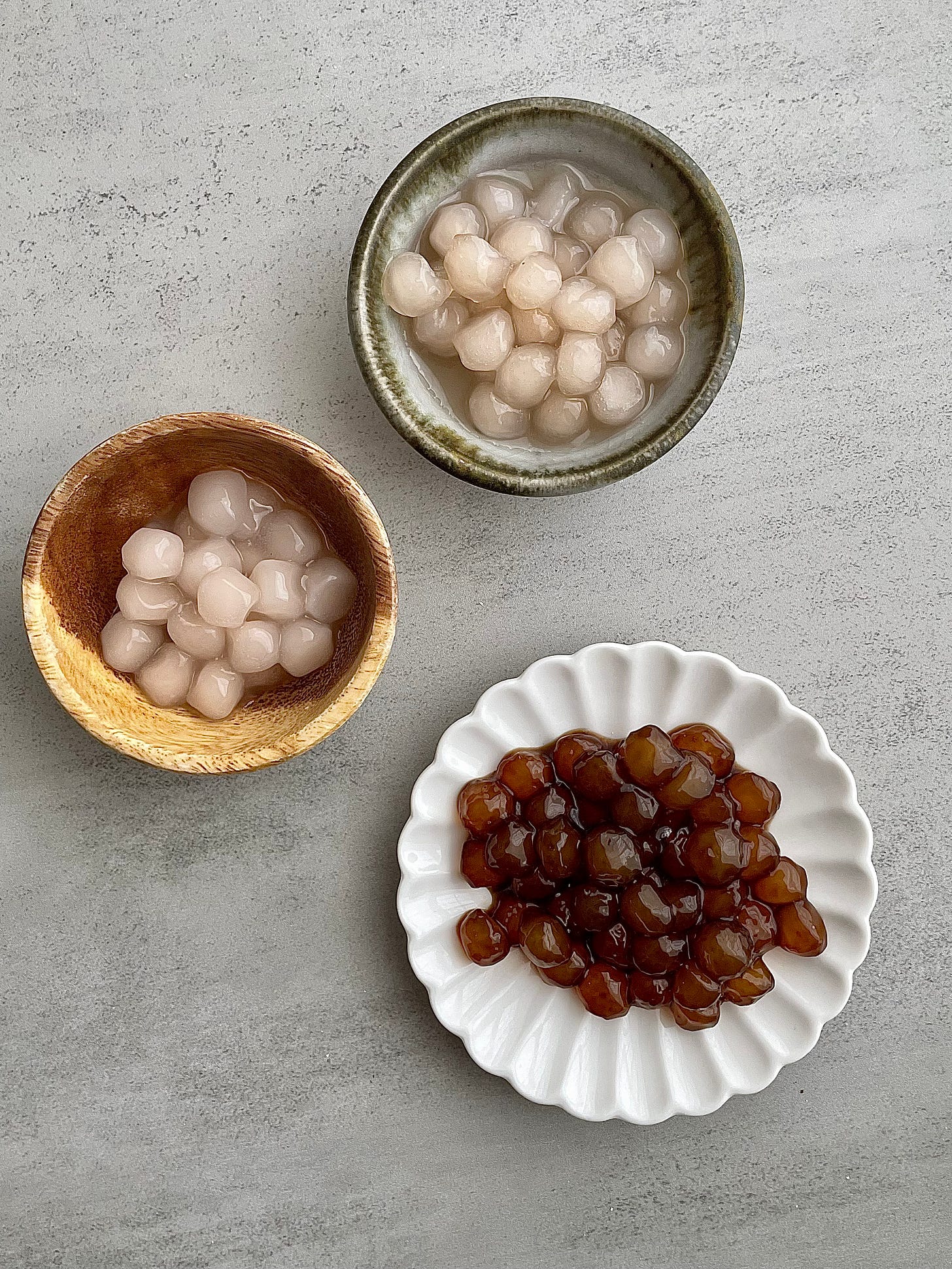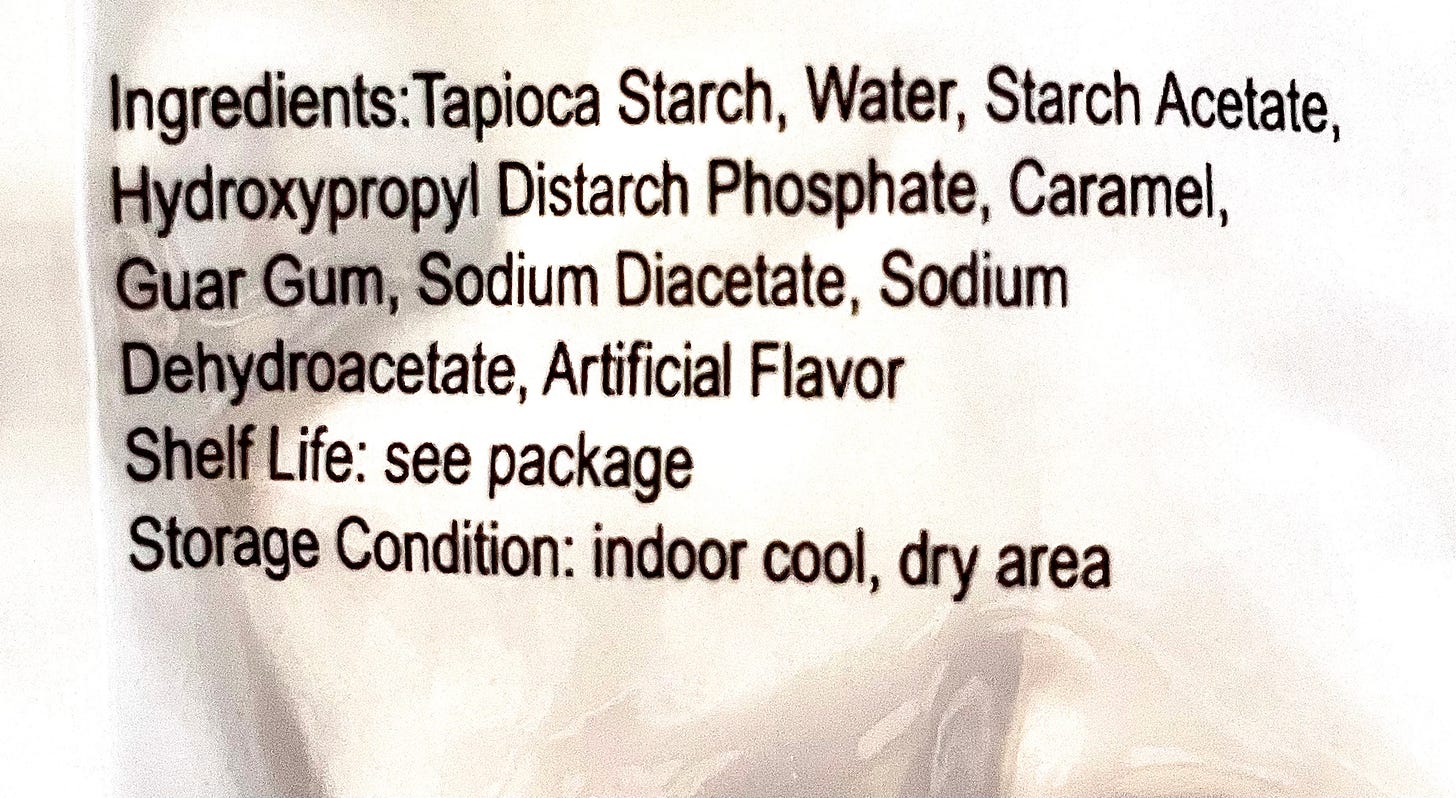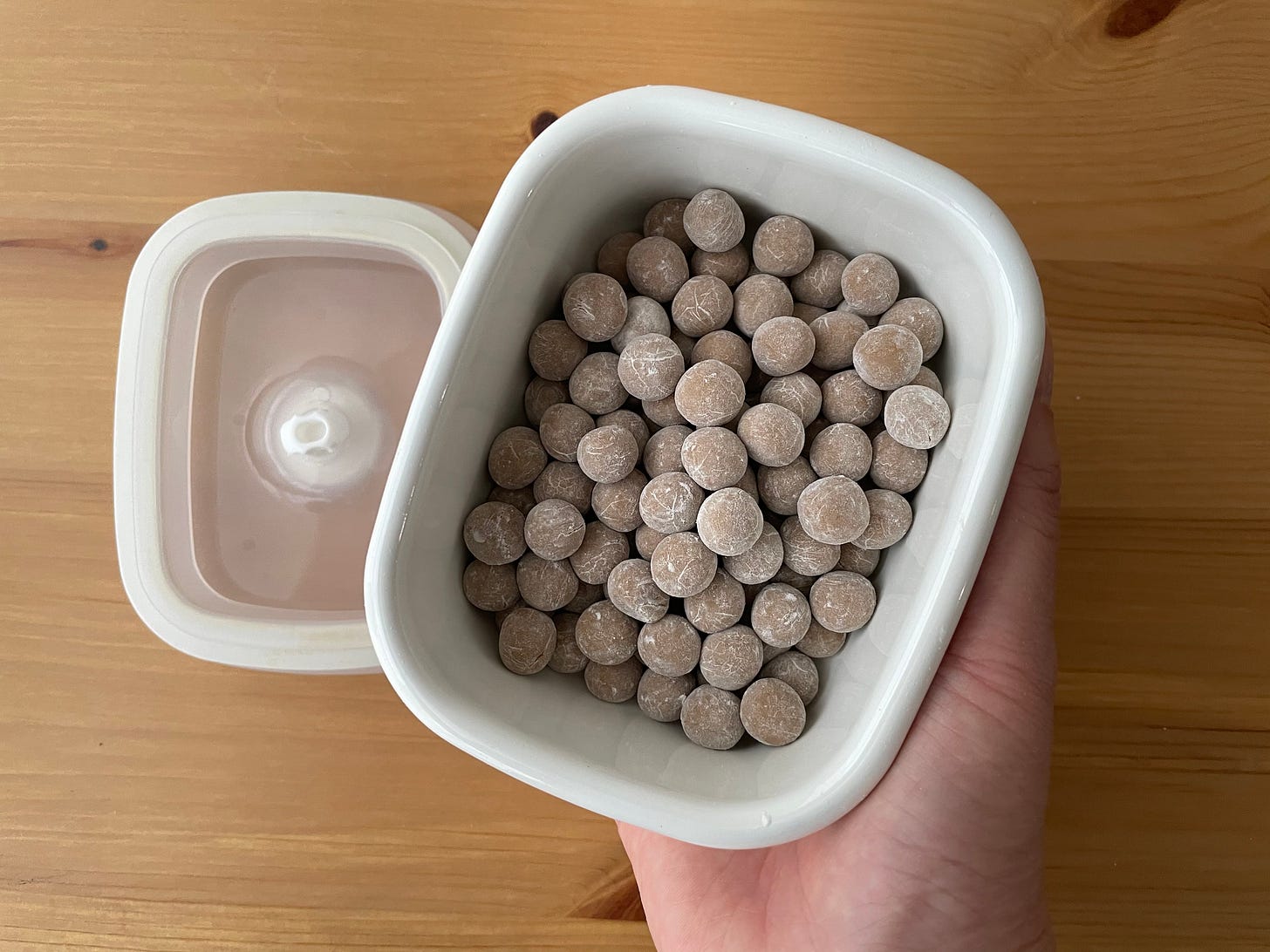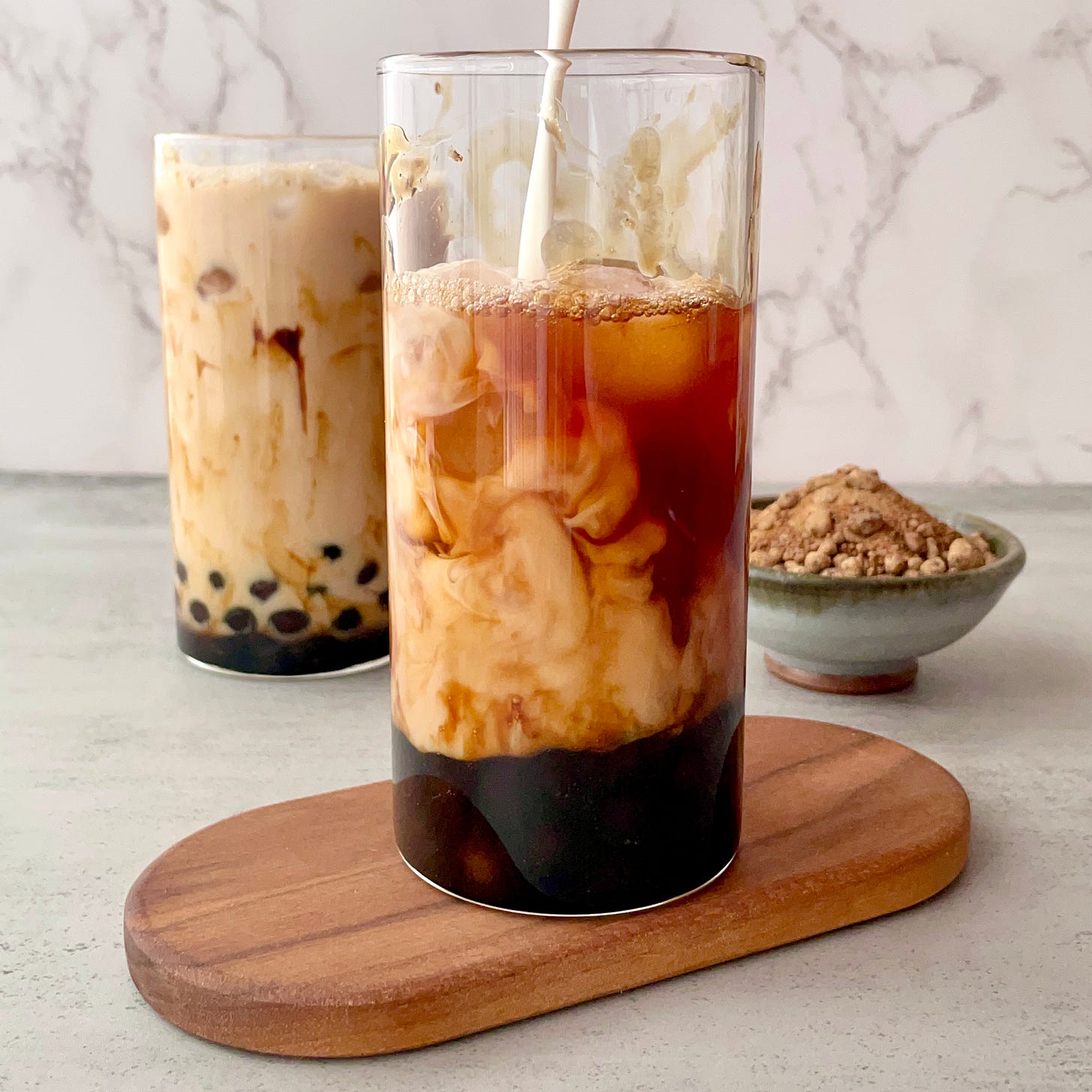The Book of Boba Tea, Chapter 2: Tapioca Balls (第二章:珍珠篇)
The path of making tapioca balls calls for those who are courageous
In the last chapter, we made two types of tea concentrates, explored ways to turn them into milk teas, and made a sugar syrup to sweeten them to our taste. Today, we’re taking a deep dive into the making of tapioca balls, also known as pearls (珍珠) , boba (波霸), or bubbles. I LOVE their chewy texture, or QQ texture, as we say in Taiwan. It’s so fun to watch them come up the boba straws and to chew them with great enthusiasm. The fragrant black sugar flavor is intoxicating. Together with the bold flavor of tea, and the creaminess of milk, tapioca balls add so much enjoyment and textural interest to a beverage. The act of chewing is also good for destressing, increasing one’s focus, and combating sleepiness. No wonder I instinctively crave boba when I’m about to enter a period of deep work (I’m having a boba right now as I write this post ^^ ).
Tapioca balls can be made with just 3 ingredients and seem easy enough to make. Yet the simplest things in life can be the hardest to get right. I ended up tweaking and testing my recipe 13 times!
Even though it was at times frustrating, I got to know the properties of tapioca starch pretty well. I’m going to give you everything I learned from the 13 batches I’ve tested so you can get it right in one try. I’m going to show you what a successful dough is like. Even if the dough doesn’t come out right the first time, I have ways for you to fix it so make sure you follow along to the end.
Why make tapioca balls at home?
Perhaps the biggest reasons to make them at home are health and cost. Getting boba is such a treat. In the US, boba shops are places where many Asian Americans hang out, not just Taiwanese Americans. I love how it’s been embraced by the greater Asian diaspora. Yet for many such as myself, the cost of the habit can add up quickly. Also, unlike in Taiwan, not every boba store offers fresh ingredients and different milk options. Many still make milk teas with non-dairy creamer powder, artificial flavors, and food colors. Have you also wondered, what’s in commercial tapioca balls?
Commercial and store-bought tapioca balls are very convenient. I have purchased a brand or two of quick-cook boba balls that are ready in 5 minutes. But one day I decided to look at the ingredients list:
What are even starch acetate, hydroxypropyl distarch phosphate, sodium diacetate and sodium dehydroactetate? I had to look them up:
Starch acetate: stabilizer, thickener, binder, emulsifier
Hydroxypropyl distarch phosphate: thickener, stabilizer, binder, emulsifier
Sodium diacetate: preservative, pH regulator, flavor enhancer
Sodium dehydroacetate: antimicrobial, fungicide, preservative
Even though these ingredients are considered safe to be used in food in the US, I just don’t feel good about their long-term consumption.
Ingredient Notes
If we strip away artificial colors, flavorings, and preservatives, we only need 3 ingredients to make tapioca balls: tapioca starch, Taiwanese black sugar, and water.
Taiwanese black sugar (黑糖) is an unrefined sugar traditionally made from evaporated boiled cane juice that is cooked and reduced to a dark syrup and dried. I’ve seen it sold at most Asian supermarkets, or you can find some online. You can find it in powder form or cube form, though for this recipe the powder form would be much easier. If you can’t find it, brown sugar would do, or darker sugar products made from evaporated cane juice from other cultures. I’m thinking piloncillo from Mexico, or jaggery powder from India. Just make sure you have a powder/granulated from so they dissolve easily in water.
Tapioca starch (木薯粉), also called cassava starch, is the starch derived from the cassava root. It’s easy to find around the world. Just note that it is different from cassava flour, which is made from the whole cassava root.
If you’re in Taiwan, look for products with the English name “tapioca starch“ as Chinese names can cause a lot of confusion. Due to the increasing costs of producing sweet potato flour, for quite a few years, products labeled as sweet potato flour (地瓜粉) were in fact tapioca starch, imported from Southeast Asia and much cheaper. Tai bai fen (太白粉), or Tai bai starch, in Taiwan could either be tapioca starch (木薯粉) or potato starch. So just follow the English labels.
For this recipe, I’ve tested both Bob’s Red Mill tapioca flour and Erawan’s tapioca starch, and they both work great.
How is a successful dough for tapioca balls achieved?
To make tapioca balls, we dissolve the sugar in water, and bring it to a boil. We then add a small portion of the starch into the boiling water, creating a partially gelatinized mixture. Gelatinization happens when starch granules are heated in a liquid, causing them to swell and burst, which results in the liquid becoming gooey.
Why do we do this? Without a little help from gelatinized starch, there is very little structure to hold the shape of the dough together if we simply mix water with starch. It becomes a dough that is hard when squeezed but oozes like a liquid when you lay it on a surface. Pretty cool huh? There’s even a name for this kind of mixture: a non-Newtonian fluid. It makes for a fun science experiment but not good when making tapioca balls.
Then why don’t we just cook all the starch? If we gelatinize too much of the starch, the dough becomes very elastic, like a super thick rubber band, and very hard to shape and work with, especially after the dough’s been cooled down.
Characteristics of a successful dough
To make a successful tapioca ball dough is therefore achieving the goldilocks amount of gelatinization for it to be strong enough to hold shapes like little balls, but soft enough to work with and smooth out any cracks. The dough should feel moist but does not stick to your hands, and is slightly more elastic than play dough. If you pull the dough apart, it might be like chewing gum for a few seconds, but eventually break (Bottom left). Below is a video showing you side-by-side the three different textures of dough you might end up with:
How to fix dough issues
If your dough ends up looking like the top middle or top right, here’s what to do to transform it into a successful dough:
If the dough looks like an oozing mudslide with no structure (top middle): there wasn’t enough gelatinized starch. Mix 1 tbsp of water and 1 tbsp of starch, and cook in a small pot until it becomes translucent and extremely stretchy. Knead that back into the dough, adding additional starch and water if needed.
If the dough is too elastic and coils back when stretched (top right): there’s too much gelatinized starch. Simply add more starch and water in small amounts.
INGREDIENTS
90g 3/4 cup tapioca flour, divided into 2 tbsps and 1/2 cup+ 2 tbsps
60ml/1/4 cup water
42g/3 tbsp black sugar
13g/1 tbsp brown sugar
DIRECTIONS:
Making the dough
Reserve 2 tbsps of tapioca flour from the measured amount. Have it close by.
In a small pot, boil the water and black sugar together, stirring often to help the sugar dissolve.
Once the water has been boiling for a minute, turn off heat. Immediately dump in all the reserved 2 tbsps of tapioca starch. Working quickly, stir until the sugar water and starch have been well mixed, and about half the slurry has gelatinized into translucent, stretchy little bits, and half of it still looks muddy and liquidy (See video below). Turn the heat back to the lowest setting for a few seconds at a time if necessary.
Dump in the rest of the tapioca starch all at once, stirring well. Using a crisscross motion, cut the flour into the dough. You’ll have little bits of dough and some raw starch, that’s ok.
Turn everything out from the pot onto a bench, scraping every bit of dough off from the pan. Knead the dough with your hands until even and smooth. Be careful, the dough might still be hot. Knead until the dough is slightly sticky but doesn’t leave residue on your hands, elastic but holds its shape and doesn’t contract when released. Adjust the dough texture with water, tapioca flour, or more cooked starch as necessary (see “How to fix dough problems“ for details ). Wrap dough in seran wrap.
Working in small portions, shape the dough into smooth and round balls, about 1g each, or about 1 cm or the diameter of a Sharpie cap. Keep the rest of the dough covered while you’re not working on it. Sprinkle some extra tapioca starch onto the balls to prevent them from sticking to each other. Remember to keep the balls small: they expand when cooked and need to fit through boba straws!
Cook the tapioca balls
Prepare a big pot of water, at least 8-10 cups, and bring to a roaring boil. Add the tapioca balls in while stirring the pot, making sure they don’t stick to the bottom of the pot. Once the balls float to the top, close the lid, turn the heat to medium, and boil for 20 minutes. Give it a stir every 5-10 minutes. After 20 minutes or when the balls are cooked through but the center is chewier, turn the heat off, put the lid on, and let stand for 30 minutes. Now, the balls should be even in texture, bouncy, but pleasant to chew. Move the balls into a small bowl, add a tbsp of brown sugar, and stir well to prevent sticking. Add to your drink of choice and enjoy with a wide straw, either hot or cold.
Storage
Raw tapioca balls can be coated with more starch and stored in an airtight container in the freezer for up to 3 months
Cooked tapioca balls are best consumed right away, at most within 2-3 hrs. They cannot be stored in the fridge as it changes its texture irreversibly.
There are many, many recipes and posts about making tapioca balls. They differ in method (dump the starch into the pot, pour the boiling sugar water into the starch, etc) and ratio of starch to water. I couldn’t find tips on what to do when I didn’t create a workable dough on my first try, resulting in MANY, many wasted doughs in the trash. I hope this post can help you avoid my mistakes and heartaches. Once you know the objective of the recipe, the characteristics of a successful dough, and how to fix the dough if it’s not quite right, you can make tapioca balls at home like a champ!
Stay tuned for the next chapter, where we take our boba milk teas to the next level!












Thanks for sharing! They came out just right on my first try! (I used HK brown sugar)